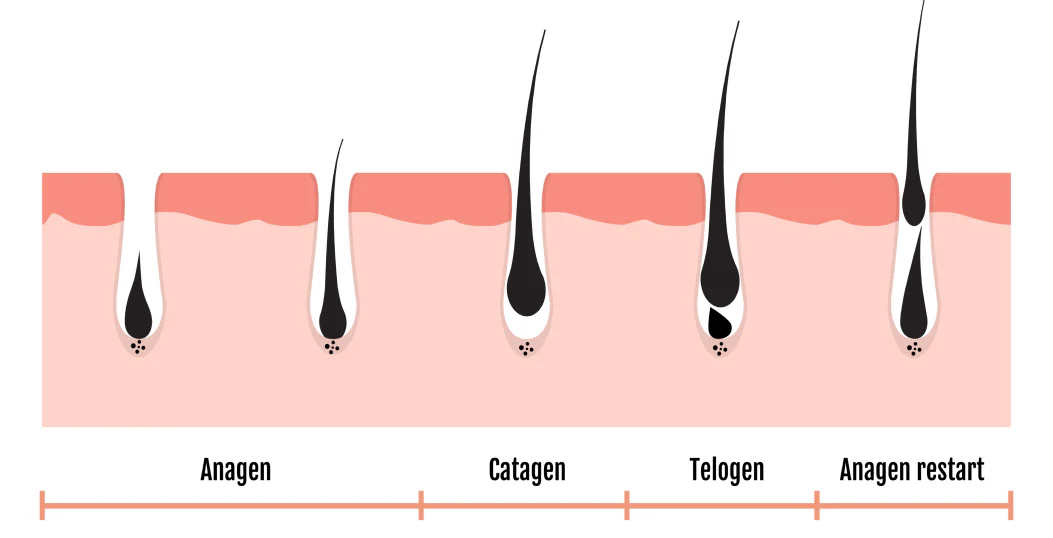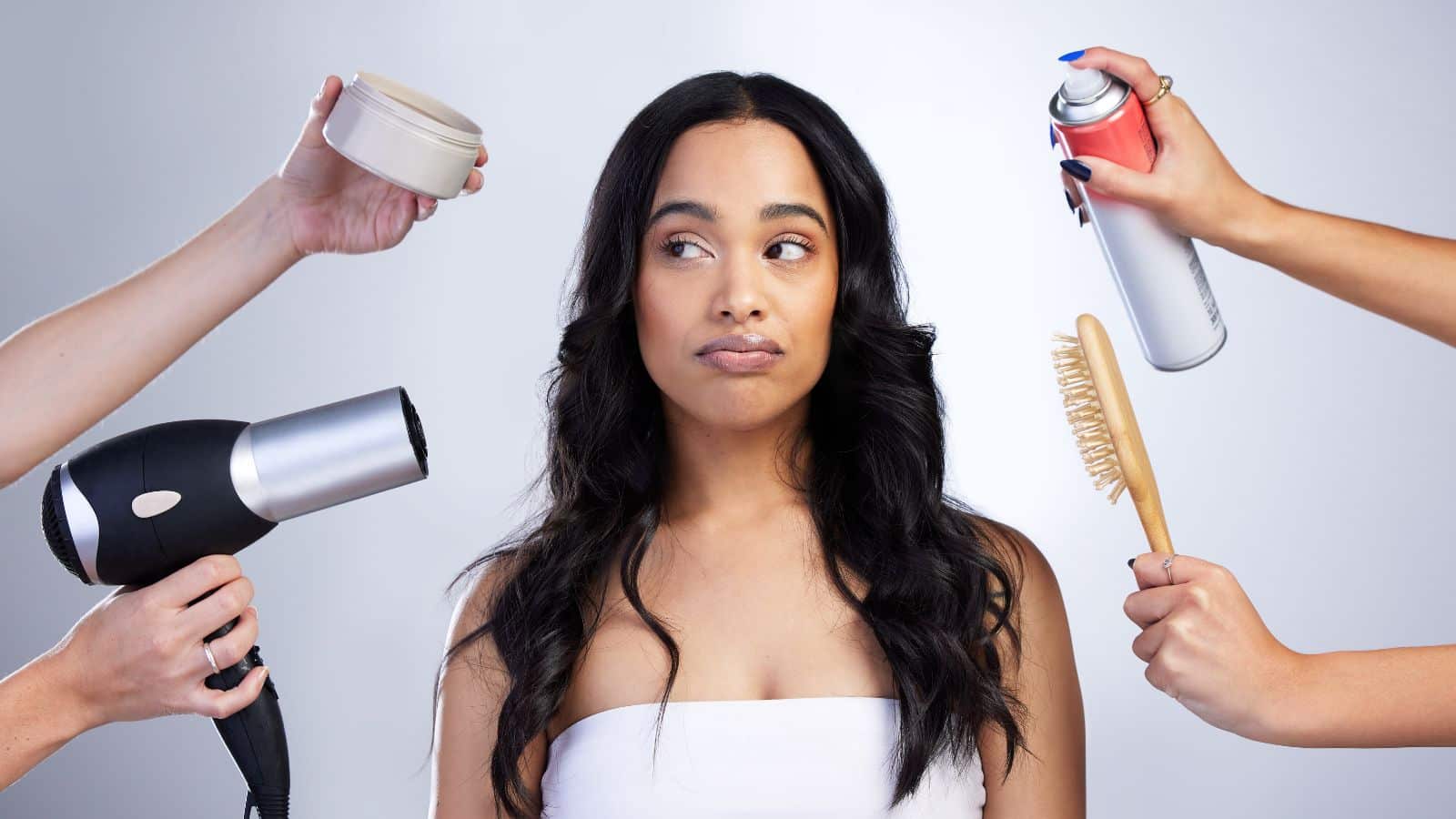 October 29, 2024 | Hair Tips
October 29, 2024 | Hair TipsAre you tired of waiting for your hair to grow? Do you dream of having long, luscious locks but feel like your hair just isn’t growing fast enough? You’re not alone in this struggle. Many people face slow hair growth, but there are ways to speed it up and achieve your hair goals.

Hair growth is a complex process influenced by genetics, age, hormones, and health. While you can’t control everything, there are steps to promote healthy hair growth and speed it up.
Creating an effective hair care routine is crucial. Choose the right shampoo and conditioner for your hair type. Wash your hair at the right frequency and use nourishing products. Regular trims are also key to maintaining healthy hair and preventing split ends, which can slow growth.
Key Takeaways
- Create an effective hair care routine tailored to your hair type
- Choose nourishing shampoos and conditioners
- Wash hair at the appropriate frequency for your hair and scalp needs
- Regularly trim hair to prevent split ends and maintain healthy growth
- Understand the factors influencing hair growth, including genetics, age, hormones, and overall health
Introduction
Growing longer, healthier hair is a common goal for many. It can be frustrating and slow. There are ways to make your hair grow faster and promote overall hair health.
Maintaining a healthy scalp is crucial for growing healthy hair. A clean, well-nourished scalp provides the ideal environment for hair follicles to thrive. Regular scalp massages stimulate blood flow, promoting hair growth.
A balanced diet rich in essential nutrients supports healthy hair growth. This includes protein, iron, vitamins A and C, and omega-3 fatty acids. Staying hydrated is also key for maintaining healthy hair and preventing dry, brittle strands.
Preventing damaged hair from heat styling, harsh chemical treatments, and environmental stressors is vital. Using heat protectant products and opting for gentler hair care routines can help. Protecting your hair from the sun and other damaging elements minimizes breakage and split ends.
Regular trims can help your hair grow by removing split ends, the weakest parts of the strands. If left untrimmed, split ends can travel up the hair shaft and cause even shorter hair. Aim for a 1/4-inch trim every 3 months, as your hair grows about 1/2 inch per month.
Stress can impact hair growth. High levels of stress can cause hair loss and slow down hair growth. Managing stress through techniques like meditation, yoga, or therapy can help promote healthier hair growth.
Understanding the factors that influence hair growth is key. Implementing a comprehensive hair care routine addresses both internal and external factors. This creates the optimal conditions for growing longer, healthier, and more beautiful hair.
Understanding The Hair Growth Cycle
To achieve healthy hair growth and maintain strong, lustrous locks, it’s crucial to understand the hair growth cycle. This cycle consists of three main phases: anagen, catagen, and telogen. By familiarizing yourself with these stages, you can better tailor your hair care routine to promote optimal hair health and increase hair growth.

The Three Phases of Hair Growth
The hair growth cycle is divided into three distinct phases:
- Anagen Phase: This is the active growth phase, lasting anywhere from 3 to 5 years, or even up to 7 years for some individuals. During this stage, your hair grows approximately half an inch per month, totaling about 6 inches per year. An estimated 90% of the hairs on your head are in the anagen phase at any given time.
- Catagen Phase: The catagen phase is a transitional stage that lasts around 10 days. During this phase, hair growth slows down, and the hair follicle shrinks. Approximately 3% of all hairs are in the catagen phase at any time.
- Telogen Phase: The telogen phase is the resting stage of the hair growth cycle, typically lasting about 3 months. During this phase, the hair follicle remains dormant, and the hair may fall out more easily. An estimated 10-15% of hairs are in the telogen phase at any given time.
| Phase | Duration | Percentage of Hairs |
|---|---|---|
| Anagen | 3-5 years (up to 7 years for some) | 90% |
| Catagen | 10 days | 3% |
| Telogen | 3 months | 10-15% |
Why Hair Stops Growing: Common Factors
Several factors can disrupt the hair growth cycle and cause hair to stop growing or fall out prematurely. Some common reasons include:
- Nutritional Deficiencies: A diet lacking in essential nutrients like vitamins, minerals, and protein can lead to hair loss and slower hair growth. Ensure you consume a balanced diet rich in vitamins, iron, fiber, and protein to support healthy hair growth.
- Stress: Excessive stress can extend the time spent in the resting phases of the hair growth cycle, leading to increased hair shedding and slower growth. Stress can also trigger conditions like telogen effluvium, trichotillomania, and alopecia areata.
- Hormonal Imbalances: Hormonal changes, such as those experienced during menopause or pregnancy, can disrupt the hair growth cycle and cause temporary hair loss or thinning.
- Damage from Styling: Excessive heat styling, tight hairstyles, and harsh chemical treatments can damage your hair and lead to breakage, making it more difficult for your hair to grow long and strong.
“By understanding the hair growth cycle and the factors that influence it, you can take steps to optimize your hair care routine and promote healthy hair growth.”
Incorporating hair products tailored to your specific hair type and concerns, such as those designed for thinning hair or to increase hair strength, can help you maintain healthy hair at every stage of the growth cycle. With the right care and attention, you can achieve the long, lustrous locks you desire.

Creating an Effective Hair Care Routine
For those aiming to grow their hair faster, a well-structured hair care routine is key. By adopting expert advice and using the right products and methods, you can stimulate hair growth and keep your scalp and hair healthy. Here’s how to craft a hair care routine that promotes faster hair growth.
Cleansing: Choosing the Right Shampoo and Frequency
Finding the right balance in hair washing is crucial. Most hair types only need washing every other day or a few times a week. Fine, straight hair often requires more frequent washing than thicker, curlier, or wavier hair. Here are some general guidelines for washing frequency based on hair type:
- Dry hair: Wash every third day
- Oily hair: Wash every other day or daily if excessively oily
- Normal hair: Wash every other day or every 3 days
When selecting a shampoo, choose sulfate-free formulas to preserve moisture and reduce frizz. Also, wash your hair with lukewarm water to avoid stripping natural oils.
Conditioning for Growth and Repair
Conditioning your hair after each shampoo is vital for maintaining moisture, preventing damage, and restoring natural oils. A weekly deep-conditioning treatment is recommended for all hair types, especially fine, curly, or color-treated hair. When applying conditioner, focus on the ends of your hair, as they tend to be the most damaged and prone to dryness.
For an extra boost of moisture and shine, consider using a leave-in conditioner, especially if you have dry hair or style your hair frequently. Leave-in conditioners can help smooth frizz and flyaway strands while providing additional hydration.
Regular Trims: Myth or Essential?
It’s a common myth that regular trims can make hair grow faster. Hair grows from the roots, not the ends. However, regular trims are still essential for maintaining healthy hair and preventing split ends. Most professionals recommend at least three dustings or trims a year to keep your hair in top condition.
If you’re prone to split ends, you may need to trim your hair more frequently. A celebrity hairstylist suggests getting a haircut every 4 to 6 weeks for short hair and every 3 months for long hair. By keeping your ends healthy and free of damage, you can create the appearance of faster hair growth.
| Hair Type | Washing Frequency | Conditioning Tips |
|---|---|---|
| Dry Hair | Every third day | Use a deep conditioner weekly and a leave-in conditioner for extra moisture |
| Oily Hair | Every other day or daily if excessively oily | Focus conditioner on the ends and use a lightweight formula to avoid weighing hair down |
| Normal Hair | Every other day or every 3 days | Use a balanced conditioner and deep condition as needed |
Scalp Care Essentials
While focusing on the health of your hair is important, don’t forget about your scalp! A healthy scalp is the foundation for luscious, longer hair. If you’re struggling with hair thinning or excessive hair shedding, it’s time to give your scalp some TLC. Here are some essential scalp care tips to help hair grow faster and stronger.
Exfoliation: The Key to Removing Product Buildup
Just like your face, your scalp can benefit from regular exfoliation. Over time, products, oils, and dead skin cells can accumulate on your scalp, leading to buildup that can clog hair follicles and hinder growth. Incorporate a gentle scalp scrub or exfoliating shampoo into your routine once or twice a week to keep your scalp clean and balanced. This simple step can help hair grow healthier and reduce hair shedding.
Scalp Massages for Improved Blood Flow
Scalp massages aren’t just relaxing; they can also strengthen your hair by increasing blood circulation to the hair follicles. Improved blood flow means more nutrients and oxygen reach the follicles, promoting healthier hair growth. You can give yourself a scalp massage while washing your hair or use a scalp massager tool. For an extra boost, try massaging your scalp with a few drops of rosemary oil, which has been shown to potentially increase hair thickness and treat hair loss.
One research study found that stress to the scalp can cause cuticular cells to be less flexible, making hair more likely to shed or break.
Keeping Your Scalp Clean and Balanced
A healthy scalp is a clean scalp, but that doesn’t mean you need to wash your hair every day. Over-washing can strip your scalp of its natural oils, leading to dryness and irritation. Aim to wash your hair every 2-3 days, depending on your hair type and lifestyle. When you do wash, focus on massaging the shampoo into your scalp rather than your strands. This will help remove buildup and keep your scalp clean without drying out your hair.
| Healthy Scalp | Unhealthy Scalp |
|---|---|
| Adequate sebum production | Excessive oiliness or dryness |
| Clean and free of buildup | Flakiness and itching |
| No redness or inflammation | Redness, bumps, and irritation |
| Promotes healthy hair growth | Thinning hair and breakage |
Remember, a healthy scalp is the key to achieving the thick, luscious locks you’ve always wanted. By incorporating these scalp care essentials into your routine, you can get your hair growing faster and stronger than ever before, even if you have fine hair. Show your scalp some love, and you’ll be on your way to your best hair yet!
Top Hair Growth Products: What Works and What Doesn’t
By middle age, four out of five men and half of women face hair growth issues. This makes finding effective hair growth products a priority.
Understanding Hair Growth Oils
Hair growth oils can enhance your hair care routine, promoting faster hair growth and protecting against damage. We evaluated 26 oils and serums to identify the best. The Mielle Organics Scalp and Hair Strengthening Oil, priced around $10, is a top choice with over 60,000 perfect five-star ratings. Other effective options include:
- Maple Holistics Pure Rosemary Essential Oil (1 oz)
- The Ordinary Multi-Peptide Serum (2 oz)
- Kintsugi Awakening Mist (4 oz)
Serums and Leave-In Treatments
Serums and leave-in treatments offer targeted support for hair growth and prevent loss. We tested six treatments for their effectiveness. The Advanced Trichology NutraM DHT Blocking Hair Serum showed visible growth after one month. Hers’ Minoxidil foam, an FDA-approved treatment, improved growth in a month. The Virtue Hair Growth Treatment routine, including shampoo, conditioner, and Minoxidil, promoted hair regrowth in four weeks.
| Product | Size | Key Ingredient |
|---|---|---|
| Women’s Rogaine 5% Minoxidil Foam | 2.11 oz | 5% Minoxidil |
| Hers Minoxidil Topical Hair Regrowth Solution | 2 oz (1 month supply) | Minoxidil (for women) |
| Amazon Basic Care Minoxidil Topical Solution | 6 oz (3 month supply) | 2% Minoxidil |
Growth-Enhancing Shampoos and Conditioners
The right shampoo and conditioner are crucial for hair growth. We tested over 20 shampoos to find the best for various needs. Vegamour GRO+ Advanced Replenishing Shampoo led to about 1/2 inch of growth in six weeks. Redken Extreme Length Shampoo promoted fullness and new growth in two weeks.
In a study, 52% of participants experienced improved hair density and up to 76% had less hair shedding after using a specific shampoo.
Other notable shampoos include DS Laboratories Antioxidant Hair Density CBD Shampoo, which improved density in thinning hair patches after about three weeks. Luseta Beauty Jamaican Black Castor Oil Shampoo rehydrated and strengthened dry, weak curly hair. The Redken Extreme Length Conditioner showed about 0.5 inches of growth after three weeks.
Summary
Growing hair faster and keeping it healthy involves gentle care, a balanced diet, and managing stress. If your hair isn’t growing as quickly as you’d like, examine your hair care routine. Avoid harsh shampoos that remove natural oils, limit heat styling, and brush gently to prevent breakage. Regular trims every 8-12 weeks also help maintain hair health and prevent split ends.
Your diet and lifestyle significantly impact hair growth. A balanced diet rich in protein, biotin, and other nutrients is crucial. Stress management through exercise, meditation, and adequate sleep can also aid in hair growth. If hair loss persists, consult a healthcare professional to check for underlying health issues.
While there’s no overnight solution for faster hair growth, adopting a gentle care routine and nourishing your hair from within can help. Protecting your hair from damage is also key. Be patient and consistent with these habits for luscious locks over time.
Frequently Asked Questions
How can I prevent heat damage to my hair while styling?
To avoid heat damage, always apply a heat protectant spray. Set your styling tools to the lowest effective temperature. Work quickly to minimize exposure time. It’s also wise to avoid daily use of heat styling tools to give your hair a break.
Is it okay to brush my hair when it’s wet?
Wet hair is more susceptible to breakage. It’s best to let it air-dry or gently detangle with a wide-tooth comb. Avoid brushing wet hair to prevent damage and slow down growth.
Can chemical treatments affect hair growth?
Bleach and other chemical treatments can weaken hair, leading to breakage before reaching your desired length. To promote faster hair growth, minimize chemical treatments or choose gentler alternatives.
Are there any medications that can help with hair growth?
Minoxidil, an over-the-counter medication, can help retain hair and even regrow some. Continuous use is necessary for sustained results. Prescription medications like spironolactone and finasteride can also treat hair loss.
How often should I trim my hair to promote growth?
Regular trims can help your hair grow by removing split ends, the weakest parts of the strands. Aim for a 1/4-inch trim every 3 months, as your hair grows about 1/2 inch per month.
Can stress affect hair growth?
Severe stress can put hair into a resting phase, skipping the growth stage. It may also increase the risk of alopecia areata or trichotillomania. Reducing stress or managing it may help hair grow back.
What nutrients are essential for healthy hair growth?
Ensuring adequate protein intake (50 grams or more per day) is crucial for hair growth. Deficiencies in iron, vitamins B and D, zinc, omega-3 fatty acids, and biotin can affect hair health. A doctor can test for deficiencies and recommend supplements if needed.
How can I care for fragile hair types, like Black hair?
Fragile hair needs extra care. Avoid over-washing, just enough to remove product buildup. Get relaxer touch-ups from a professional every 2-3 months, only on new growth. Treat your hair to a hot oil treatment every couple of weeks and use conditioner every time you shampoo.
Can sudden weight loss lead to hair loss?
Sudden weight loss can trigger hair loss. Ensure your diet provides enough protein, as your body will prioritize it for other functions over hair growth. Hair will grow back when nutrition returns to normal, but a healthy, slower-paced diet plan is better for overall health and hair.
How can I promote healthy hair growth while sleeping?
To promote healthy hair growth while sleeping, get 7-9 hours of sleep per night. Use a silk or satin pillowcase to prevent friction and tangling. Avoid sleeping with wet hair, as it can weaken strands and lead to breakage or matting.
